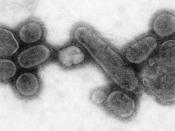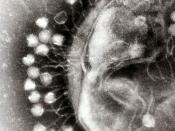A simple essay on computer viruses Could have added more examples
Viruses: Complex Molecules or Simple Life Forms?
Viruses have been defined as 'entities whose genomes are elements
of nucleic acid that replicate inside living cells using the cellular
synthetic machinery, and cause the synthesis of specialised elements that
can transfer the genome to other cells.' They are stationaryand are unable
to grow. Because of all these factors, it is debatable whether viruses
are the most complex of molecules or the simplest life forms. While the
definition of living organisms must be adapted, the majority of evidence
leads to the classification of viruses as living organisms.
Viruses are composed of a nucleic acid core, a protein capsid, and
occasionally a membraneous envelope. The nucleic acid core is composed of
either DNA or in the case of retroviruses, RNA, but never both. In
retroviruses, the RNA gets transcribed to DNA bye the enzyme reverse
transcriptase. The protein capsid is a protein layer that wraps around
the virus. There are four basic shapes of viruses. The tobacco mosiac,
adenovirus, influenza virus, and t-even bacteriophage are each examples of
a different virus structure. Each individual protein subunit composing the
capsid is a capsomere.
The tobacco mosiac virus has a helical capsoid and is rod shaped.
The adenovirus is polyhedral and has a protein spike at each vertex. The
influenza virus is made of a flexible, helecal capsid. It has an outer
membranous enevelope that is covered with glycoprotein spikes. The T-even
bacteriophage consists of a polyhedral head and a tail. The tail is used
to inject DNA into a bacterium while the head stores the DNA.
Basic life is defined as the simplest form capable of displaying
the most essential attributes of a living thing. This makes the only real
criterion for life the ability to replicate. Only systems containing nucleic
acids are capable of this phenomenon. With this reasoning, a better
definition is the unit element of a continuous lineage with an individual
evolutionary history. Because of viruses inability to survive when not in
a host, they must have evolved from other forms of life. The origin of
viruses is an easy thing to theorize about so many hypothesese have been made.
One such hypothesis is that viruses were once complete living
parasites. Over time they have lost all other cellular components. This is
backed up by the idea that all cells degenerate over time.
Some people think along very similar lines that viruses are
representatives of an early 'nearly living' stage of life. This goes along
with the first hypothesis in that it accounts for a loss of components. All
creatures that become parasitic can be seen losing their obsolete functions
and structures. An example of this is the flea. Fleas are eveolved from
flies but have discarded their unneeded wings.
This theory when applied suggests that atleast some branches of
viruses have evolved from bacteria because of their similar natures.
Scientists say that at one point viruses could have been independant
organisms. As they slowly became parasitic, the unsed structures for protein
and energy synthesis were lost, along with the inhibiting cell wall. While
viruses do need a host cell to complete many important functions of living
organisms, the should still be considered living themselves.
The ability to replicate is important to the classification of an
item as living. Within the host, viruses are able to replicate, evolve, and
even mutate. They are deeply intertwined in the life process by this
dependancy on a host.
Viruses are very specific to what they can use as a host. Despite
the specificness, many viruses can host withmembers of different species,
genus, and even phylums. A lock and key fit determines the host, or host
range. This works vert similar to that of an enzymes active site.
Once the virus has found a host cell, the virus uses the host's
nucleotides and enzymes to replicate it's DNA. Other materials and machinery
of the host cell produce the virus's capsid proteins. The viral DNA and
proteins then join to make a new copy of the virus.
While viruses are inactive when in transport between hosts, the
arguements are overwhelmingly in favor of considering viruses living organisms.
Through their parasitic nature, they are able to fulfill most qualities of
living organisms. Their behavior and complexness also lead to this
classification. While they are not the text book example of living organisms,
is has been in agreement that there always will be exceptions to the rules.
Viruses deserve to take their rightful place among the ranks of living
organisms.


